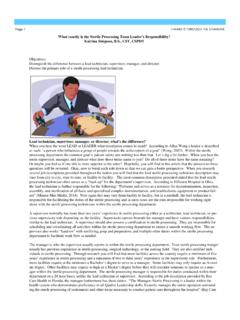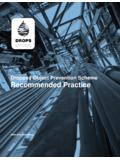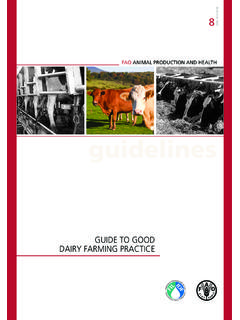Transcription of In-service — Recommended Practices for Central …
1 VOLUME 17 ISSUE 3 JULY 2006 Page 4 In-service Recommended Practices for Central sterile Pamela H Caudell, RN, CNOR, CSPDS Objectives: At the end of the article, staff will be able to: 1. Define what Recommended Practices are, 2. List at least two organizations that have been involved in writing Recommended Practices , 3. Show how Recommended Practices are used to write policy and procedure. Recommended Practices are written by selected members of the Association for Perioperative Nurses, members from the Centers for Disease Control and Prevention, the Association for Pro-fessionals in Infection Control and Epidemiology, the American Society of Healthcare Central Ser-vice Professionals, the International Association of Healthcare Central Service Material Management, the American College of Surgeons and the Ameri-can Society of Anesthesiologists.
2 Each recom-mended practice is reviewed and revised as appro-priate at regular periodic intervals. These Recommended Practices are based on princi-ples of microbiology, scientific literature, research and the opinions of experts and are periodically updated to reflect research data and advanced tech-nology. They represent official positions on ques-tions of aseptic and technical Practices used by both the OR and Central sterile . 1 These Practices represent the optimal level of prac-tice. In other words, these Practices are our guide-lines in doing the right things at the right time for the right results for our patients.
3 Originally there were several different organizations writing rec-ommended Practices , all of which were different variations on the same theme. In fact, AORN was the first organization to actually have a book pub-lished on Recommended Practices in early 1975. However, there started to be major discrepancies between the different groups, owing in part, to the different sources each group used. So, the Asso-ciation for periOperative Nurses (AORN), the As-sociation for the Advancement of Medical Instru-mentation (AAMI), the American Society for Hos-pital Central Service Professionals (ASHCSP), and the International Association of Healthcare Central Service and Materials Management (IAHCSMM) all starting talk-ing to each other and decided to collaborate in order to get the right answers to their questions about how to do their job right.
4 For instance, in the Central sterile arena, we follow both AORN and AAMI standards. The reason we do this is because AORN Practices deal more with the clinical as-pect of our jobs while the AAMI Recommended Practices deal more with the use, maintenance, evaluation and proc-essing of medical devices. One of the reasons this is so important is because not all instruments are processed in the same area. For instance, the cleaning of endoscopes can and often is done in two separate areas. They could be cleaned and sterilized in the OR, the GI lab or in Central sterile .
5 There has to be Practices in place so that no mat-ter where the instruments are cleaned and sterilized, the same process applies. That the same decontamination process is used whether it is decontaminated in the OR or Central sterile . Now this doesn t mean that only these groups are involved in the process of writing Recommended Practices . By no means are they the only groups involved. For instance, the Recommended practice on personal protective equipment (PPE) not only involved the groups listed above but the Centers for Disease Control (CDC) and the Occupational Safety and Health Administration (OSHA) were brought in to help set the goals for the practice.
6 The Infection Control group also played a large part in the writing proc-ess as they were able, along with the CDC, to bring to the rest very specific scientific knowledge about germs, bacte-ria and virus in order to be able to protect both the patient and the staff member handling the instrumentation at the end of the case. Currently there are over sixteen (16) Recommended prac-tices that deal with Central sterile in the AORN Stan-dards, Recommended Practices and Guidelines. These documents represent what is considered to be the best Practices for Central sterile departments to follow in order to; optimize Infection Control efficacy, cost control and patient and personnel safety.
7 It is thru the development of these sixteen Practices that managers have been able to write policies and procedures that each department uses to govern how their department will work in coordina-tion with the individual facility. These guidelines are also useful when speaking with administrative personnel that do not understand the relationship between cost control and clinical awareness. For instance, because scrub clothes are so expensive and the replacement ratio is so high, certain hospital ad-ministrations have demanded that scrub clothes be individually bought and laundered at home.
8 Be-cause of the Recommended Practices from both AORN and AAMI, there is documentation that shows that home laundry water temperatures do not reach a temperature high enough to kill certain forms of bacteria and virus so exposure to scrubs taken home and laundered could potentially create a favorable environment for the growth of germs both to the patient and to the family members of staff. If your administration still has problems getting around the concept of home laundry being a no-no, you can always use the OSHA guidelines to show that expo-sure to bloodborne pathogens creates a significant risk to the patient, who by having less than optimal health, do not have the normal bodily defenses nec-essary to prevent Surgical Site Infections, for in-stance.
9 This, again shows how the different agen-cies have worked together in order to present to the healthcare community a Recommended practice that is useful for all users. Another Recommended practice deals with steriliza-tion. Not only does AAMI have a Recommended practice for the set up of a Central sterile depart-ment, there are also Recommended Practices that help us write polices that govern how we decontami-nate our instruments as well as what type of packag-ing material we use during sterilization. Groups such as FDA, AAMI and AORN as well as OSHA govern thru Recommended Practices what types of personal protective equipment (PPE) we use for what type of procedure we are doing.
10 Association for the Advancement of Medical Instrumentation (AAMI), the Association for periOperative Nurses (AORN), the Center for Disease Control and the Association for Professionals in Infection Control and Epidemiology have all gotten together to pro-duce Recommended Practices for sterilization. These Practices include setting up a Central sterile depart-ment inclusive of air flow, both positive and nega-tive and traffic flow patterns in order to prevent staff from cross-contaminating clean areas by VOLUME 17 ISSUE 3 JULY 2006 PAGE 5 coming in contact with contaminated equipment and in-struments to name just a couple.





